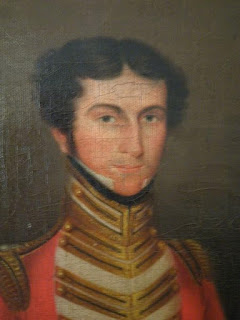Jim Belshaw continues the story of Terrible Vale, the Taylors and the early days of the New England pastoral industrySoon after bringing Margaretta Lucy Lind and the children to Terrible Vale in 1844, William Tydd Taylor had built a new woolshed on the property about 100 yards from the newly constructed homestead. That plus the homestead and the nearby barn and men’s quarters made for a small settlement.
The
woolshed was needed.
The
depression that gripped NSW in the early 1840s made money hard to obtain and
yet money was constantly required to develop the early New England runs and to
bridge the financial gap between the annual sales of the wool clip.
With scarce
capital, the NSW Legislative Council agreed changes that allowed loans to be
advanced on the security of unshorn wool and mortgages over livestock. In
February 1845, this allowed Taylor to borrow £1,200 pounds from Stuart
Alexander Donaldson secured by mortgage over 9,696 sheep.
Donaldson and
Taylor would later be in Parliament at the same time, with Donaldson becoming
the first Premier of NSW.
With
growing sheep numbers, Taylor faced the challenge of collecting the flock,
washing them and then bringing them to the new shearing shed where the wool was
clipped and baled.
Washing the
sheep was important. Grazing, sheep collected grit and burrs that added to the
weight of the wool and made it harder to process. Washed wool attracted a premium, something
that was important to cash strapped pastoralists.
But washing
sheep was also hard, back-breaking work. Today we forget just how much physical
labour was involved in making a living in our very recent past.
This
applied as much to women as men. Maintaining a household, especially a large
household, required constant work.
On Terrible Vale, washing the sheep was
done in October prior to sheering. Sheep had to be collected from across the
property and then penned in a specially constructed yard near the creek. There
they were driven into the creek.
In the
creek, a line of men standing in waste deep cold water would take the sheep and
try to clean it before passing it on to the next man. At the end of the chain,
the sheep were hauled out onto the bank and placed in a yard to dry.
Have you
ever tried to lift a fully grown ewe? In Armidale parlance I’m a townie, but I
have and they are bloody heavy. So imagine a scene in which protesting wet wool
sheep (wet sheep are heavier because of the weight of the water) are swimming
or being pushed along a line while men scrub them.
October can
be cold, so following hours of this work the sheep are cold but the men are
frozen. To help them continue, men were often given a ration of grog in the
middle of the process.
Once the
sheep were washed, they had to be shorn. The shearing gangs that would become a
feature of New England life did not yet exist, so everybody helped.
Shearing
completed, the wool was dispatched to London, first by Port Macquarie, later
Morpeth. Now began the anxious wait. Would the wool get there? What price would
it get?
Note to readers: This post appeared as a column in the Armidale Express Extra on 22 June 2016. I am repeating the columns here with a lag because they are not on line outside subscription. You can see all the Belshaw World and History Revisited columns by clicking here for 2009, here for 2010, here for 2011, here for 2012, here for 2013, here for 2014, here for 2015, here for 2016.


















